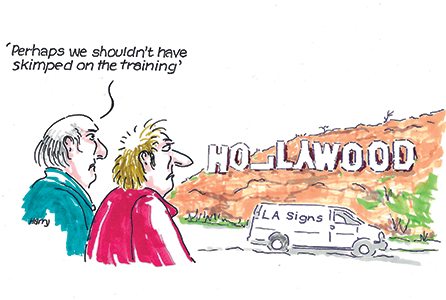
David Catanach, director of the BSGA, tackles the question of employee training and whether the sign-making industry is shooting itself in the foot by not taking up opportunities
No-one can argue against a fully-trained, competent workforce as being essential in today’s sign industry. There is a danger that businesses will find themselves being left behind as those that do invest in training and skills continue to win more business to the detriment of the less able.
Customers recognise this and will go with talent and competency over poor standards and inefficiency.

The simple fact is that a trained person is less likely to make mistakes that would cost money to put right”
The thing is, if you are in a sign business, you should already have acquired a certain level of training relevant to the equipment you use and the products you supply. You have therefore already invested in training one way or another, but why stop there and limit your horizon? The simple fact is that a trained person is less likely to make mistakes that cost money to put right. I would argue therefore that an investment in training is actually saving money with knock-on benefits for the future of your business.
My soapbox point is this: raise the requirement of training much higher up the scale in your business plan and do something about it. I have yet to see a business that invested in training for its employees and directors fail. It has never been a wasted investment.
Should it be compulsory?
If a business is a small- to medium-sized enterprise (SME), finding time and money for training staff is one of the many challenges. It is often considered as ‘nice to have but not essential’ and I can quite understand the reasoning behind such a position. However, I would advocate at least a yearly review on the requirement.
On the official front, unless more sign businesses enrol employees for NVQ (QCF) qualifications, two things will happen. First, the local colleges that currently provide the assessment and support will drop sign-making and installation courses due to lack of interest and, secondly, government funding allocated to this sector will go else-where making training and skills even more difficult to come by.
Without an apprentice scheme or an NVQ/QCF programme, the only option is material/equipment specific courses. I am not suggesting that every sign business should stop what they are doing and send their workforce off for training—each business to its own—but training must come higher up the agenda of business practice (if it is not already up there) if a business is to thrive and grow.

The BSGA does not control government spending policies. We can only go in (like many other industries do), plead our case, and abide by the rules. One of these rules is that if not enough people are using the money available, then the money will be put to use elsewhere where it is needed.
The BSGA is acknowledged for encouraging and promoting a skilled workforce. Some sign-makers say the BSGA should be fighting against the requirement of CSCS (Construction Skills Certificate Scheme) cards and other ‘red tape’. That is tantamount to saying that the BSGA should condone incompetency, poor product quality, and business practice as well as ignore legal statutes.
What about the basics?
Whenever the subject matter is raised with sign-makers, the majority agree that a cost effective and industry-wide basic training programme is a definite requirement so that sign-makers can at least know that the person they are about to employ has the ability relevant to this industry.
The International Sign Association (ISA) in the USA experienced the same response and spent over a million dollars in producing an online, basic training programme (e.g. how to measure a wall and be able to centre individual letters correctly spaced) that could be followed online at the individual’s own pace, and present the employer with the employee’s progress plus the proof that required competencies had been achieved. The trainee could also demonstrate that they had acquired the knowledge by way of a recognised certificate scheme from an organisation recognisable to the sign industry i.e. the ISA. The training went live two years ago and, despite all the rhetoric from US sign-makers supporting such a programme, take-up has been, to be polite, slow.

The International Sign Association (ISA) spent over a million dollars in producing an online, basic training programme that could be followed at the individuals own pace. It also presents the sign-maker with their employee’s progress, plus the proof that required competencies have been achieved
The European Sign Federation (ESF) is in the process of providing a similar programme and it hoped to be launched later in 2015, first in Germany before spreading around other European countries. First impressions are that the German industry representatives are saying that this is a vital step towards keeping their industry in the front of skills and abilities which is essential in these tough times. The old ‘Eastern Bloc’ countries are keen as it will assist in bringing the skill sets of their work-force up to a ‘Western Europe’ standard making it easier for them to compete. Other ‘Western’ European countries are showing an interest for a basic level of competency marker in their industry. Though their attention at present is more focused on waiting for their local economy to improve, they recognise the importance of a minimum standard of competency. Make of all that what you will.
Where are we now?
Latest figures show that the number of sign industry personnel currently working towards NVQ/QCF qualifications is down compared to the same time a year ago. Local colleges providing these courses are getting harder to find. This leaves training to specific equipment, skills, and materials being the most sought after. Whilst that fulfils an immediate need, it does not provide the all-round competences necessary in today’s sign-making business.
In the case of apprenticeships, fun-ding has already been diverted towards Modern Apprenticeships and whilst fully funded for under-19 year olds, adults are also being encouraged to take up apprenticeships in order to gain funding for the courses.

Latest figures show that the number of sign industry personnel currently working towards NVQ/QCF qualifications is down compared to the same time a year ago”
NVQ (QCF) qualifications serve three primary purposes in the sign industry. Firstly, they provide the industry with a workforce that is seen to be properly and professionally train-ed and secondly they provide motivation for staff as a real and recognisable record of their achievements and abilities. Thirdly, as is well known, an NVQ (QCF) is the precursor to getting a CSCS card, without which it is increasingly difficult to work on construction sites. While on the subject, it has been noted that only CSCS card holders are being allowed to work on some ‘mature’ sites because of insurance and health and safety implications. Expect that trend to catch on elsewhere.
Return on investment
The excuse that raises its head time and time again is the one about why a business should invest money in training an employee only for said employee to leave shortly afterwards for another job?

Training your work force may seem like a bridge to far, but the benefits of a confident and highly skilled workforce will pay huge dividends in the long-term
Yes, we have a free market for employment so people will leave their employer if they think that they can do better elsewhere. After all, how many sign companies out there started up with someone leaving their current firm because they thought they could do better for themselves? But I would suggest that one way not to lose a valuable employee is by using the same principle that you would use to not lose a customer i.e. do not give them a reason to consider going elsewhere. And the good news is that it does not always involve money. Just as people buy from people, employees work better when their work environment is more conducive and they feel they are more valuable to the business.

Training, as part of a business model, should not be considered a wasted investment and that applies for every-body in the business from the top of the organisation downwards”
Training, as part of a business model, should not be considered a wasted investment and that applies for every-body in the business from the top of the organisation downwards. Outside influences are demanding a better trained and competent workforce, so why should we as an industry not take up that challenge and meet (possibly exceed) their demands?
Public Notice:
- A fully-trained workforce is essential to today’s sign-making business
- Investment in training is not throwing money away, but should be a vital part of company spending
- Without take-up from sign businesses, training courses will be dropped and government spending will decrease
- Offering training is an incentive to keep good workers in the company
The British Sign and Graphics Association (BSGA) history dates back more than 70 years when a group of leading sign-makers formed the Master Sign Makers Association (MSMA) with the aim of promoting the sign industry and defending its interests. For more information on the issues discussed in this article visit www.bsga.co.uk or Tel: 0845 338 3016
Your text here...